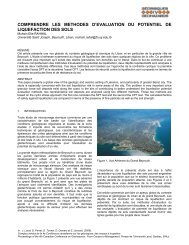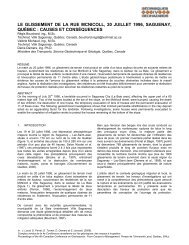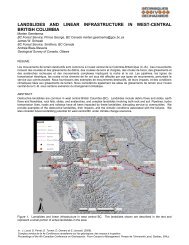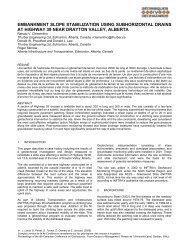Impact of global warming on stability of natural slopes
Impact of global warming on stability of natural slopes
Impact of global warming on stability of natural slopes
Create successful ePaper yourself
Turn your PDF publications into a flip-book with our unique Google optimized e-Paper software.
<str<strong>on</strong>g>Impact</str<strong>on</strong>g> <str<strong>on</strong>g>of</str<strong>on</strong>g> <str<strong>on</strong>g>global</str<strong>on</strong>g> <str<strong>on</strong>g>warming</str<strong>on</strong>g> <strong>on</strong> <strong>stability</strong> <str<strong>on</strong>g>of</str<strong>on</strong>g> <strong>natural</strong> <strong>slopes</strong><br />
vegetati<strong>on</strong> can die. These impacts essentially cause the<br />
same effects as those discussed above as a result <str<strong>on</strong>g>of</str<strong>on</strong>g><br />
precipitati<strong>on</strong> changes.<br />
Sec<strong>on</strong>dly, temperature also affects groundwater. As the<br />
hydraulic c<strong>on</strong>ductivity <str<strong>on</strong>g>of</str<strong>on</strong>g> soil is dependent up<strong>on</strong> the viscosity<br />
<str<strong>on</strong>g>of</str<strong>on</strong>g> a fluid, seepage velocity would increase due to a rise in<br />
temperature. In additi<strong>on</strong>, the groundwater body would<br />
experience thermal expansi<strong>on</strong>. This thermal expansi<strong>on</strong><br />
could lead to a rise in groundwater level. Therefore a<br />
significant temperature rise will reduce the <strong>stability</strong> <str<strong>on</strong>g>of</str<strong>on</strong>g> a<br />
<strong>natural</strong> slope.<br />
Thirdly, increasing the temperature can desiccate the soil.<br />
Whereas in some cases the lower moisture c<strong>on</strong>tent will<br />
increase soil strength parameters and beneficial soil sucti<strong>on</strong>,<br />
it can c<strong>on</strong>versely result in losses <str<strong>on</strong>g>of</str<strong>on</strong>g> soil cohesi<strong>on</strong>, for<br />
example as a result <str<strong>on</strong>g>of</str<strong>on</strong>g> fissuring <str<strong>on</strong>g>of</str<strong>on</strong>g> a clay deposit. These<br />
fissures or cracks also accelerate infiltrati<strong>on</strong> into the slope<br />
with the associated loss <str<strong>on</strong>g>of</str<strong>on</strong>g> FOS.<br />
Finally, <str<strong>on</strong>g>warming</str<strong>on</strong>g> arctic temperatures affect <strong>stability</strong> <str<strong>on</strong>g>of</str<strong>on</strong>g> <strong>slopes</strong><br />
depending <strong>on</strong> frozen c<strong>on</strong>diti<strong>on</strong>s for <strong>stability</strong>. As these<br />
permafrost <strong>slopes</strong> thaw, shallow sliding as a result <str<strong>on</strong>g>of</str<strong>on</strong>g><br />
saturated c<strong>on</strong>diti<strong>on</strong>s occur.<br />
4.4 Change in Wind Velocity<br />
Wind effects <strong>on</strong> slope <strong>stability</strong> occur in 2 ways. Indirectly,<br />
they affect vegetati<strong>on</strong> and therefore slope <strong>stability</strong>, as<br />
outlined above. This is through aggravating drought effects.<br />
This can lead to dying vegetati<strong>on</strong> through reduced moisture,<br />
and also losses associated with increased fire hazards. The<br />
lateral load <strong>on</strong> trees as a result <str<strong>on</strong>g>of</str<strong>on</strong>g> high winds from storms is<br />
another effect <strong>on</strong> slope <strong>stability</strong> when the wind directi<strong>on</strong> is<br />
downslope.<br />
4.5 Quantifying the <str<strong>on</strong>g>Impact</str<strong>on</strong>g>s<br />
The above noted equati<strong>on</strong>s were applied to a variety <str<strong>on</strong>g>of</str<strong>on</strong>g><br />
c<strong>on</strong>diti<strong>on</strong>s based first <strong>on</strong> an infinitely l<strong>on</strong>g slope. This is<br />
applicable to <strong>slopes</strong> that experience relatively shallow<br />
failures (less than a few metres deep). Sec<strong>on</strong>dly, to study<br />
the effects <str<strong>on</strong>g>of</str<strong>on</strong>g> a slope having a defined shape and where<br />
deeper failures can occur, a model was also analysed using<br />
limit equilibrium slope <strong>stability</strong> s<str<strong>on</strong>g>of</str<strong>on</strong>g>tware for circular failure<br />
modes.<br />
Analyses were applied to slope angles varying from 30 to 60<br />
degrees. Selected parameters were as follows:<br />
• Fricti<strong>on</strong> angle =30 o , typical <str<strong>on</strong>g>of</str<strong>on</strong>g> loose sand and silts<br />
as well as low plastic clays<br />
• Cohesi<strong>on</strong> as a result <str<strong>on</strong>g>of</str<strong>on</strong>g> roots: 1 kPa, representing<br />
an average reinforcement effect within the soil.<br />
• Water table: at the level <str<strong>on</strong>g>of</str<strong>on</strong>g> the slope’s toe<br />
• Soil sucti<strong>on</strong>: varying from 0 kPa at the water table<br />
to -285 kPa at ground surface<br />
• Soil sucti<strong>on</strong> fricti<strong>on</strong> angle Φ b = 15 o<br />
The results <str<strong>on</strong>g>of</str<strong>on</strong>g> <strong>stability</strong> analyses for translati<strong>on</strong> failures in an<br />
infinitely l<strong>on</strong>g slope are summarized in Tables 1 and 2.<br />
These c<strong>on</strong>firm that significant reducti<strong>on</strong>s in <strong>stability</strong>, as<br />
indicated by reduced FOS values, will occur as a result <str<strong>on</strong>g>of</str<strong>on</strong>g><br />
loss <str<strong>on</strong>g>of</str<strong>on</strong>g> vegetati<strong>on</strong> and soil sucti<strong>on</strong>, as well as a rising water<br />
table.<br />
An analysis was also made <str<strong>on</strong>g>of</str<strong>on</strong>g> circular failure modes within a<br />
generic soil slope having the same soil parameters as<br />
above. In this case, an upper z<strong>on</strong>e 2 m thick was allocated<br />
as the root z<strong>on</strong>e as well as the z<strong>on</strong>e in which soil sucti<strong>on</strong><br />
can be lost due to saturati<strong>on</strong>. The results are also illustrated<br />
in Table 2. These likewise c<strong>on</strong>firm significant reducti<strong>on</strong>s in<br />
FOS as a result <str<strong>on</strong>g>of</str<strong>on</strong>g> climate change effects.<br />
Table 1. Results <str<strong>on</strong>g>of</str<strong>on</strong>g> Circular slip analyses.<br />
30°<br />
Slope<br />
Factor <str<strong>on</strong>g>of</str<strong>on</strong>g> Safety<br />
45°<br />
Slope<br />
60°<br />
Slope<br />
Base Case 1.10 1.10 1.10<br />
FOS after root<br />
loss 1.10 1.10 1.10<br />
FOS after<br />
sucti<strong>on</strong> loss in<br />
upper 2 m 1.09 0.72 0.56<br />
FOS after loss<br />
<str<strong>on</strong>g>of</str<strong>on</strong>g> both roots<br />
and sucti<strong>on</strong> 0.96 0.56 0.43<br />
Table 2. Effect <str<strong>on</strong>g>of</str<strong>on</strong>g> Water Table Rise <strong>on</strong> Stability<br />
Water Table Level (h/H)<br />
45°<br />
Slope<br />
30°<br />
Slope<br />
60°<br />
Slope<br />
FOS<br />
Base<br />
Case 1.10 0.70 0.00 0.00<br />
Failure 0.99 0.80 0.37 0.30<br />
H/h = water table height above toe / slope height<br />
5. CONCLUSIONS<br />
Undisputed evidence has now c<strong>on</strong>firmed that the <str<strong>on</strong>g>global</str<strong>on</strong>g><br />
temperature has been increasing during the last few<br />
decades due to <str<strong>on</strong>g>global</str<strong>on</strong>g> <str<strong>on</strong>g>warming</str<strong>on</strong>g> as a result <str<strong>on</strong>g>of</str<strong>on</strong>g> increasing<br />
greenhouse gases. Climatic c<strong>on</strong>diti<strong>on</strong>s predicted from<br />
worldwide <str<strong>on</strong>g>global</str<strong>on</strong>g> <str<strong>on</strong>g>warming</str<strong>on</strong>g> will involve new precipitati<strong>on</strong> and<br />
wind c<strong>on</strong>diti<strong>on</strong>s. These will significantly affect the amount<br />
and type <str<strong>on</strong>g>of</str<strong>on</strong>g> vegetati<strong>on</strong>, groundwater levels and surface<br />
water levels. All these factors will affect the <strong>stability</strong> <str<strong>on</strong>g>of</str<strong>on</strong>g><br />
certain <strong>natural</strong> <strong>slopes</strong> due to losses <str<strong>on</strong>g>of</str<strong>on</strong>g> soil sucti<strong>on</strong>, higher<br />
groundwater tables, increases in seepage velocities,<br />
frequent occurrences <str<strong>on</strong>g>of</str<strong>on</strong>g> rapid drawdown c<strong>on</strong>diti<strong>on</strong>s, losses<br />
<str<strong>on</strong>g>of</str<strong>on</strong>g> soil reinforcement c<strong>on</strong>tributed by roots and losses <str<strong>on</strong>g>of</str<strong>on</strong>g><br />
stabilizing materials through erosi<strong>on</strong> from flooding.<br />
A review <str<strong>on</strong>g>of</str<strong>on</strong>g> potential <str<strong>on</strong>g>global</str<strong>on</strong>g> <str<strong>on</strong>g>warming</str<strong>on</strong>g> impacts <strong>on</strong> <strong>natural</strong><br />
<strong>slopes</strong> has been carried out. The impacts are significant<br />
and will result primarily from effects related indirectly to<br />
increasing run<str<strong>on</strong>g>of</str<strong>on</strong>g>f and infiltrati<strong>on</strong> as well as loss <str<strong>on</strong>g>of</str<strong>on</strong>g><br />
vegetati<strong>on</strong>. With a sound understanding <str<strong>on</strong>g>of</str<strong>on</strong>g> these







